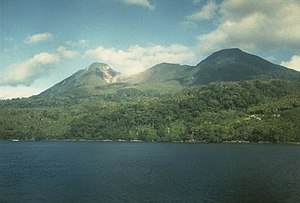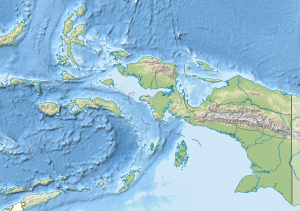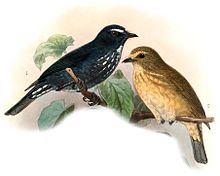Damar (island)
| Damar | ||
|---|---|---|
| The Wurlali on Damar | ||
| Waters | Banda Lake | |
| Archipelago | Damar Islands | |
| Geographical location | 7 ° 9 ′ S , 128 ° 39 ′ E | |
|
|
||
| surface | 194.47 km² | |
| Highest elevation |
Wurlali 868 m |
|
| Residents | 5560 (2010) 29 inhabitants / km² |
|
| main place | Bulge | |
| Rocks on the Damar coast | ||
Damar ( Indon . : Pulau Damer ) is one of the Indonesian Barat Daya Islands ( Southwest Islands ) in the Banda Sea .
geography
Overview
At 194.47 km² Damar is the largest of the Damar Islands with the atoll Nus Leur in the west, Terbang Utara and Terbang Selatan in the south and Teun a little further away in the east. Together they form the district ( Kecamatan ) Damar, which belongs to the administrative district ( Kabupaten ) of the southwestern Moluccas (province of Maluku ). The main town of the district is Wulur on the east coast of Damar in Solat Bay . To the west lies Romang with its offshore small islands. To the east of Teun is the island of Nila . The islands of Romang, Damar, Teun and Nila are part of the Inner Banda , a chain of islands of volcanic origin.
Highest elevation of the island is the Stratovolcano Mount Wurlali ( Wuawpla ) in the north-east of the island with 868 m . It last erupted in 1892. In 1993 there was an earthquake, landslides and smoke. 4000 people were evacuated. On January 23, 2003 there was an earthquake with a magnitude of 6.1. Hot springs emerge near the beach, southwest of the volcano. Sulfur is also found here. In the north there is also the Pahwuwi with 534 m and in the west the Akrewhi with 495 m . There are three rivers on the island. The Ajerkotta flows into the sea on the northeast coast, the Awehnjo on the northwest coast and the Aunjewnjo on the southwest coast .
District
The Damer district includes the islands of Damar, Nus Leur , Terbang Utara and Terbang Selatan , but not the somewhat remote Teun , which belongs to the Teun Nila Serua district ( Maluku Tengah administrative district ).
The district of Damer (5,560 inhabitants 2010) is divided into the seven Desa Wulur (1,497), Batumerah (687), Kuay Melu (288), Kumur (452), Bebar Timur ( East Bebar , 961), Ilih (541) and Kehli (1,134).
fauna and Flora
Until recently, the entire island was densely forested. 13 of the 38 native bird species on Damar known since the 19th century are only found in the region and are mostly dependent on the forest as a habitat. Including the endemic spotted flycatcher ( Ficedula henrici ). There are subspecies endemic to Damar of the rust-flanked gerygone ( Gerygone dorsalis kuehni ) and the large-sized thick-headed flycatcher ( Pachycephala pectoralis dammeriana ). Research in 2006 recorded 54 bird species on Damar and the Terbang Islands , 48 of them on Damar. Five of them were scientifically registered for the first time on the archipelago, 15 new for the island of Damar. Together this resulted in a list of 73 species of birds on Damar and the Terbang Islands.
In the 18th century there were numerous climbing baggers ( cuscus ), iguanas and crocodiles on Damar . Wild nutmeg trees ( Myristica fragans variety) and rattan palms flourished on the island. Sugar palms ( Arenga pinnata ), white and brown sago palms ( Metroxylon sagu in varieties) and coconut palms ( Cocos nucifera ) were used to obtain food. The Damarese obtained the juice from the inflorescence of the sugar palm as palm juice (Saguwaar, Saguer, Sagero, Zachewehr, Indian tuak, Orte) and provided it with roots of the wild mangosteen ( Garcinia species) or certain tree bark ( Xylocarpus species) to promote fermentation To inhibit alcohol and vinegar, "the drink will stay sweet for more than six months" .
Residents
Damar is the only inhabited island in the Damar Islands after the people on Teun were forcibly relocated to Seram between 1979 and 1983 . 5560 people (2010) live in seven villages ( Desa ) on Damar : Wulur (1,497 inhabitants 2010), Batumerah (687), Kuay Melu (288), Kumur (452), Bebar Timur ( East Bebar , 961), Ilih ( 541) and Kehli (1,134).
Culturally, the inhabitants of Damar form a group with the other ethnic groups of the Southwest Moluccas. The Damarese speak Austronesian languages . Eastern Damar is spoken in six villages ( Damar-Wulur , formerly also called Damar-Kehli ). It is closely related to languages on the neighboring islands of Kisar , Leti , Moa , Sermata and Romang .
West Damar ( Damar-Batumerah ) is spoken in the coastal village of Batumerah and, according to recent research, also in the village of Kuay ( Kwai ). Both villages are in the northwest. The language has some similarities with the other languages in the region, including in terms of vocabulary. However, these are lower than expected. In particular, the historical phonetics differs significantly from all neighboring languages and puts them in a special position among the languages of the region.
history
The first Europeans in this region were Portuguese sailors. During his circumnavigation in February / March 1580, the Englishman Francis Drake anchored off Bebar for a long time, where he was warmly received. The Damar Islands later became part of the Dutch East Indies .
In 1666 the Dutch East India Company established a military base on Damar, which was under the governor of Banda. This base consisted of a corporal and six soldiers. The English had previously tried to take this island, similar to Run , one of the Banda Islands . The island was subject to an upper orang kaya and various orang kayas.
Damar belonged to the Republic of South Moluccas , which was proclaimed by the Christian population of the surrounding islands in 1950 and conquered by the Indonesians in 1955.
For years, the inhabitants of Wulur and those from neighboring Kehli were in dispute over the rights of use for the uninhabited Terbang Islands and the surrounding waters. In 1986 a court ruled that this bulge was due.
economy
Damar was originally the only place in the southwestern Moluccas where sago was produced. The population lives from the sale of coconuts, cloves, grows bananas, cassava, chilli, tomatoes and papayas and they fish.
literature
- Ernst Christoph Barchewitz . East Indian travel description. His eleven-year stay on Java, Banda and the southwestern islands, cases of luck and misfortune and strange occurrences ... Chemnitz 1730, Liber II What the author opened up in India, Cap. XXXII-XXXIII, pp. 501-516
Web links
- Svetlana F. Chlenova, Mikhail A. Chlenov: West Damar Language or Damar-Batumerah, an Isolate in South-Eastern Indonesia (PDF; 94 kB)
- Colin R. Trainor: Birds of Damar Island, Banda Sea, Indonesia , November 22, 2006
Individual evidence
- ^ PNAS Islands Database
- ↑ a b Map of the Damar Islands
- ↑ Map of the Southwest Moluccas ( Memento of the original from November 22, 2011 in the Internet Archive ) Info: The archive link was inserted automatically and has not yet been checked. Please check the original and archive link according to the instructions and then remove this notice.
- ↑ Wurlali . In: Global Volcanism Program . Smithsonian Institution . Retrieved December 29, 2006.
- ^ Vulcano live
- ↑ a b c d Penduduk Indonesia menurut desa 2010 ( Memento from March 27, 2014 in the Internet Archive ) (Indonesian; PDF; 6.0 MB), accessed on January 26, 2013
- ↑ a b c d e Svetlana F. Chlenova, Mikhail A. Chlenov: West Damar Language or Damar-Batumerah, an Isolate in South-Eastern Indonesia ( Memento of the original from May 12, 2015 in the Internet Archive ) Info: The archive link became automatic used and not yet tested. Please check the original and archive link according to the instructions and then remove this notice. (PDF; 94 kB)
- ^ Birdlife International
- ^ Colin R. Trainor: Birds of Damar Island, Banda Sea, Indonesia , November 22, 2006
- ^ Ernst Christoph Barchewitz : East Indian travel description , Chemnitz 1730, pp. 532-533
- ↑ Ernst Christoph Barchewitz : East Indian Travel Description , Chemnitz 1730, p. Xx
- ↑ Mark Janse, Sijmen Tol: Language Death and Language Maintenance: Theoretical, Practical, and Descriptive Approaches , 2003, pp. 49 ff.
- ↑ Joshua Eliot, Jane Bickersteth, Sebastian Ballard: Indonesia, Malaysia & Singapore Handbook , 1996, p. 597
- ^ Ernst Christoph Barchewitz : East Indian travel description , Chemnitz 1730, p. 504
- ^ Ernst Christoph Barchewitz : East Indian travel description , Chemnitz 1730, p. 505
- ^ Ernst Christoph Barchewitz : East Indian travel description , Chemnitz 1730, pp. 501–502
- ↑ Dedi Supriadi Adhuri: Selling the Sea, Fishing for Power, 7th Marine Tenure and the Politics of Legality: Cyanide Fishing




